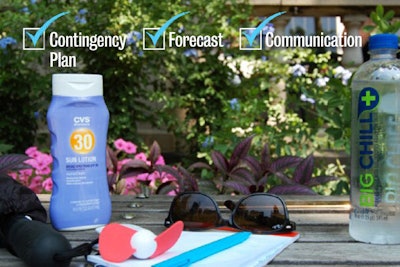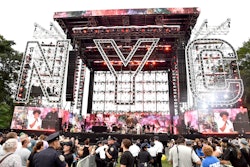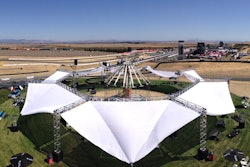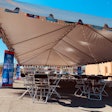
Weather-related disasters like the stage collapse at the Indiana State Fair are deadly reminders to be prepared for any weather contingency when planning an outdoor event. Here are eight ways to protect your event, guests, and crew.
1. Start planning for contingencies early.
Wayne Mahar of Precision Weather says planning for severe-weather safety should begin weeks or months in advance. Go over the possible scenarios with all key team members. “[Planning] includes everything from different types of weather events to short and long lead times for sending [guests] home to predetermined locations,” he says.
2. Do your research.
While you may plan for the most obvious natural phenomena like heavy winds or rain, don’t forget to research other potential pitfalls specific to the venue or region, or to the time of the year. “I’ve worked in the event industry for more than 25 years and thought I had seen everything,” Town & Country Event Rentals event director Adam Martin says. “While installing a spectacular wedding in [California’s] Santa Ynez Valley, I was to discover that the ceremony location was set within a tarantula migration zone. As I was to learn on the event day, in early autumn, male tarantulas migrate during mating season, and let me tell you, it wasn’t just the bride that was walking this aisle.”
3. Monitor weather forecasts.
Don’t rely on just your local news channel’s forecast for guidance; an event’s planning requires more specific and nuanced detail. Jacob Worek of the Event Safety Operations suggests resources including the local National Weather Service forecast office, the Storm Prediction Center (part of the National Weather Service), and the National Hurricane Center. You might also consider hiring a private company to provide up-to-date weather information. “A private weather service works only for you and your event,” says Mahar, whose company has worked with events like the Academy Awards and the Cannes Film Festival. “Private forecasts pinpoint your exact location and take into consideration your event’s proximity to bodies of water, hills, and any other local effects.” In addition to hour-by-hour updates, the service provides a meteorologist available to answer weather-related questions 24 hours a day.
4. Designate decision makers.
Early in the planning process, designate key people who are critical in the event of a weather emergency. In addition to law enforcement and security, medical staff, and the public relations team, the event announcer and front-office personnel should be informed to communicate updates to guests. Also, appoint a sole decision maker. “In fast-breaking weather with large crowds, you don’t have time to find your managers, call a meeting, and vote on what to do,” Mahar says. “You must have someone in the know with the latest information who can make critical decisions right now.”
5. Make a communication plan.
Worek recommends having a written plan that defines potential weather-related trigger points like high winds or heavy rain and what actions are required in response. Clearly communicate evacuation procedures and shelter points, and “most importantly, you should ensure that all event employees have read and understand the plan and their individual responsibilities within it,” he says. “Your methods and procedures for doing so should be considered in advance, and account for a variety of possible conditions: Do you have power? Light? Mobile service? Radios?”
6. Pick a venue with weather in mind.
“Your site should be chosen with an eye toward operations during a worst-case scenario,” Worek says. “If severe weather arises and you needed to evacuate your guests, how easy would it be to get everyone off site quickly and safely? If you needed assistance from emergency services, how long would it take for them to arrive?” Consider site characteristics such as potentially hazardous large trees or utility lines, as well as if permanent structures are available for shelter. Examine the layout and identify egress points, and place seating and structures away from exit routes and areas likely to be affected by high winds.
7. Provide cover and cooling.
“It may seem intuitive, but planners sometimes neglect to provide guests with adequate shade from direct sunlight,” says Kevin Dana, director of marketing and product development at Cort Trade Show and Event Furnishings. “Tents with no walls work best to allow guests to mingle and network while also letting some sunlight in.” Offering handheld fans and plenty of water stations keep guests cool and avoid potential liability issues related to dehydrated attendees. Martin notes that you should consider staff, too. “Make sure your crew is well equipped with hats, sunscreen, and plenty of water.”
8. Secure tents and structures.
In extreme weather conditions, tents and other temporary structures pose a significant threat. Dana notes that most structures are engineered to withstand wind gusts from 70 to 90 miles per hour—but only if they’re installed properly. Securing hard-paneled walls at the bottom, top, and sides of tents will help minimize flexing and shaking caused by winds.


















![“One of the harder installs was at Drees Pavilion [in Covington, Kentucky]. It was only a day apart from another filming. We re-carpeted the entire space and set everything up in 12 hours,” Bruner said.](https://img.bizbash.com/files/base/bizbash/bzb/image/2020/08/IMG_6734.5f34173fa6723.png?auto=format%2Ccompress&fit=crop&h=112&q=70&w=112)
